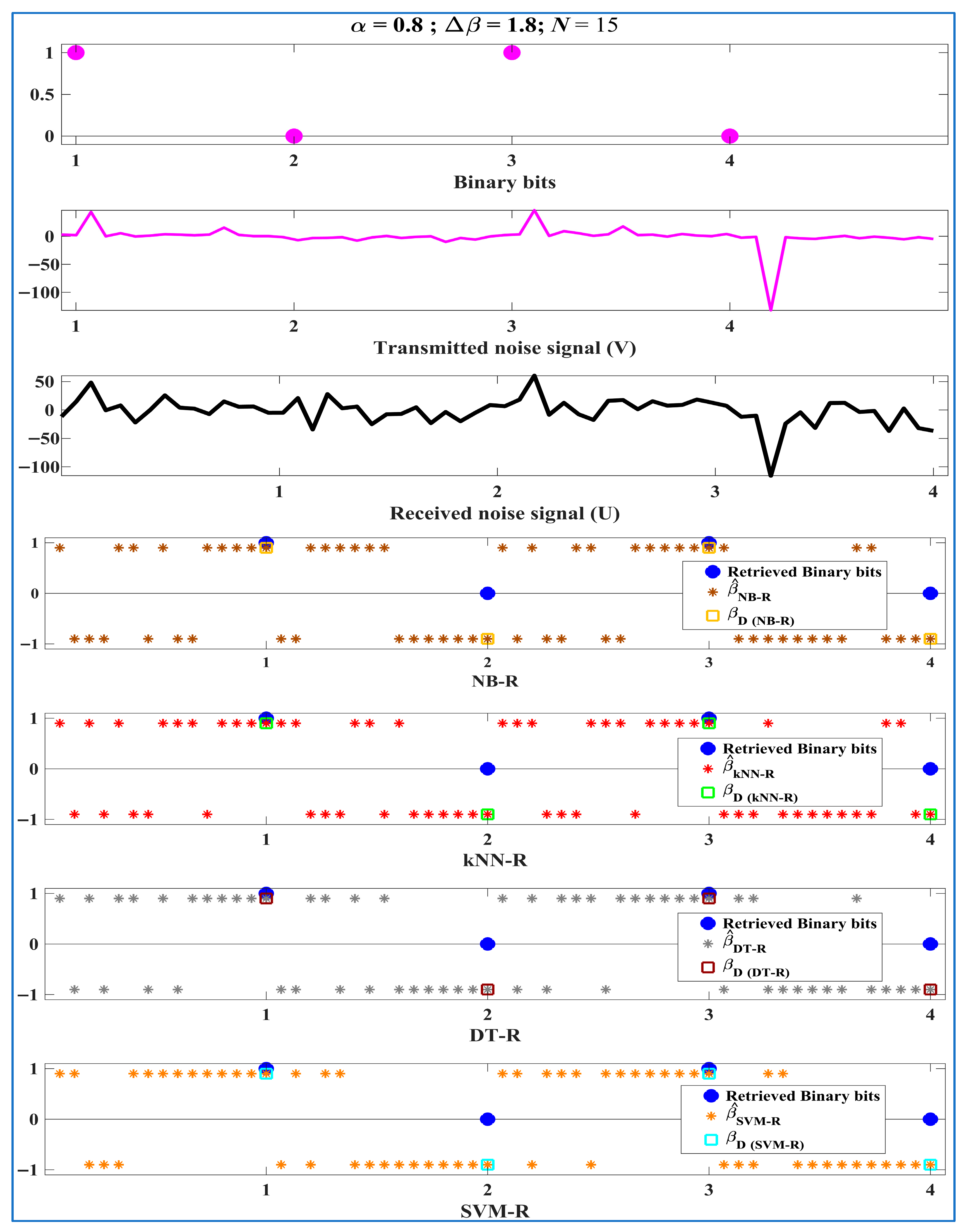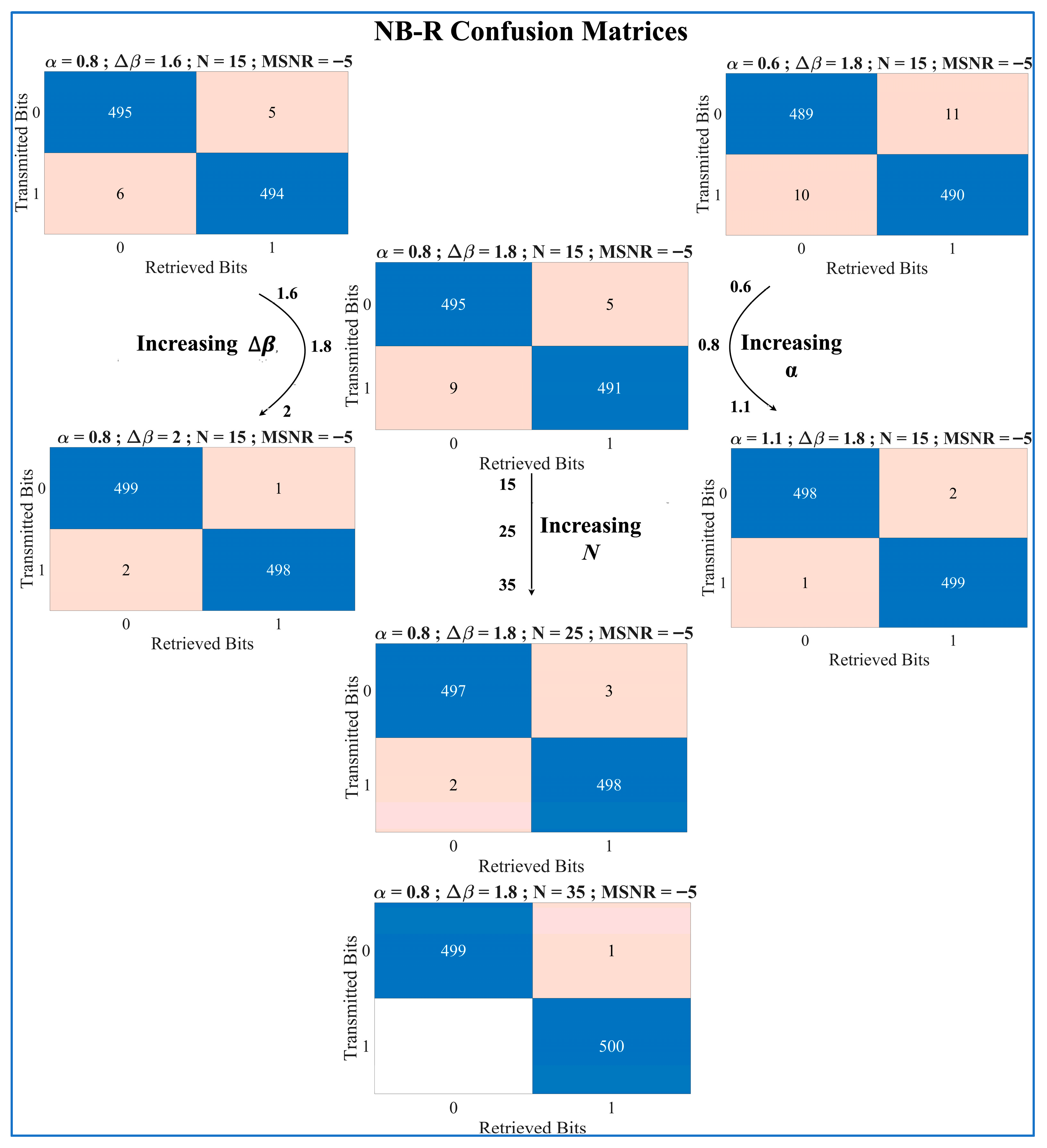Machine Learning for Enabling High-Data-Rate Secure Random Communication: SVM as the Optimal Choice over Others
Abstract
1. Introduction
- Check the multi-classifier architecture of RCS.
- Achieve a higher data rate through RCS by incorporating ML-aided receivers.
- Propose a secure unconventional security architecture.
- Establish performance benchmarks for machine-learning-driven RCSs.
- Multi-classifier architecture of RCSs: To the best of our knowledge, no previous study has conducted a unified comparison of multiple classifiers in α-stable random communication systems. Therefore, we have exploited the integration of support vector machines (SVM), Naïve Bayes (NB), k-Nearest Neighbors (kNN), and decision trees (DT) into a single unified design to encrypt and decrypt α-stable noise signals.
- Higher data rate: We have achieved significantly higher data throughput for all ML classifiers than previously proposed static estimators. SVMs are prominent among them all. They will help narrow the data throughput gap between unconventional RCSs and conventional communication systems.
- Enhanced security against eavesdropping: The proposed unified architecture also ensures that an eavesdropper fails to extract hidden binary information without a restricted-access dataset and the static pulse length key.
- Benchmark for future research: We have provided comparative performance and security analyses of the renowned ML classifiers for possible integration with RCSs. This can be considered a benchmark for future RCS architecture incorporating ML for developing next-generation secure, covert, and high-rate unconventional communication systems.
2. Physical Layer Security via Machine Learning
3. Unified Architecture
3.1. Restricted-Access Mode
3.1.1. Random Noise Modulator (RNM)
- The characteristic exponent () governs impulsiveness and ranges within (0, 2].
- The skewness parameter () determines distributional asymmetry within [−1, 1].
- The scale parameter () controls dispersion over (0, ).
- The location parameter () shifts the distribution along the real axis with μ ∈ (−, ).
- : 0.6–2.0 with increments of 0.1.
- Δβ: 0.2–2.0 with increments of 0.25.
- N: 5–500 with increments of 1.
3.1.2. Channel Impairments
3.1.3. Intended Receivers
3.1.4. 4-Bit Transmission
3.2. Open-Access Mode
Eavesdropper-Receiver (E-R)
4. Transmission and Analysis
4.1. Confusion Matrix Analysis
4.1.1. Intended Receivers
4.1.2. Eavesdropper-Receiver
4.2. Bit Error Rate Analysis
Intended Receivers
4.3. Data Rate Comparison
- A lower MSNRdB reflects a very severe presence of AWGN and vice versa. The comparative analysis reflects that the proposed HDR-MLRCS can achieve the ideal BER of in very harsh channel conditions. Moreover, the architecture provides the feasibility of achieving it with all intended receivers. The achievement of BER = at the MSNRdB = −15 by SVM-R specifically portrays the lowest possible value among all RCS architectures.
- Similarly, achieving the ideal BER by NB-R, kNN, and DT-R at the lowest MSNRdB values demonstrates the robustness of the HDR-MLRCS in establishing and maintaining secure communications under severe channel impairments.
- Most importantly, we can attain this level of performance with = 15 and = 35 at lower MSNRdB values. It follows that the proposed HDR-MLRCS can securely transmit one binary digit with only 15 noise samples. In contrast, the closest architectures require 500 to 2000 samples to do this. This reflects that the unified architecture can transmit approximately ( = 33 to = 133) more bits, in one time duration, compared to all previous architectures.
5. Conclusions
Author Contributions
Funding
Data Availability Statement
Conflicts of Interest
Abbreviations
| HDR-MLRCS | High-Data-Rate Machine-Learning-Driven Secure Random Communication System |
| AWGN | Additive White Gaussian Noise |
| RCS | Random Communication System |
| BER | Bit Error Rate |
| MSNRdB | Mixed Signal-to-Noise Ratio |
| RNM | Random Noise Modulator |
| ML | Machine Learning |
| 5G/6G | Fifth Generation/Sixth Generation |
| SVM-R | Support Vector Machine-Aided Receiver |
| NB-R | Naïve Bayes-Aided Receiver |
| kNN-R | k-Nearest Neighborhood-Aided Receiver |
| DT-R | Decision Tree-Aided Receiver |
References
- Balendran, A.; Beji, C.; Bouvier, F.; Khalifa, O.; Evgeniou, T.; Ravaud, P.; Porcher, R. A scoping review of robustness concepts for machine learning in healthcare. npj Digit. Med. 2025, 8, 38. [Google Scholar] [CrossRef]
- Guidotti, D.; Pandolfo, L.; Pulina, L. A systematic literature review of supervised machine learning techniques for predictive maintenance in Industry 4.0. IEEE Access 2025, 13, 102479–102504. [Google Scholar] [CrossRef]
- Rizvi, S.M.A.; Paracha, U.I.; Khalid, U.; Lee, K.; Shin, H. Quantum Machine Learning: Towards Hybrid Quantum–Classical Vision Models. Mathematics 2025, 13, 2645. [Google Scholar] [CrossRef]
- Damjanović, D.; Biočić, P.; Prakljačić, S.; Činčurak, D.; Balen, J. A comprehensive survey on SLAM and machine learning approaches for indoor autonomous navigation of mobile robots. Mach. Vis. Appl. 2025, 36, 55. [Google Scholar] [CrossRef]
- Dritsas, E.; Trigka, M. Machine Learning in Information and Communications Technology: A Survey. Information 2024, 16, 8. [Google Scholar] [CrossRef]
- Celik, A.M.; Eltawil, A. At the dawn of generative AI era: A tutorial-cum-survey on new frontiers in 6G wireless intelligence. IEEE Open J. Commun. Soc. 2024, 5, 2433–2489. [Google Scholar] [CrossRef]
- He, H.; Wen, C.; Jin, S.; Li, G.Y. Model-driven deep learning for MIMO detection. IEEE Trans. Signal Process. 2020, 68, 1702–1715. [Google Scholar] [CrossRef]
- Marin Machado de Souza, R.; Holm, A.; Biczyk, M.; de Castro, L.N. A systematic literature review on the use of federated learning and bioinspired computing. Electronics 2024, 13, 3157. [Google Scholar] [CrossRef]
- Weththasinghe, K.; Rajatheva, N.; He, Y. Machine learning-based channel estimation for 5G new radio. IEEE Wirel. Commun. Lett. 2024, 13, 1133–1137. [Google Scholar] [CrossRef]
- Kee, H.L.M.; Ong, L.C.; Tan, W.H.; Teo, K.T.K. A review on machine learning for channel coding. IEEE Access 2024, 12, 89002–89025. [Google Scholar] [CrossRef]
- Elsadig, A.; Gafar, A. Covert channel detection: Machine learning approaches. IEEE Access 2022, 10, 38391–38405. [Google Scholar] [CrossRef]
- Gebrezgiher, Y.T.; Jeremiah, S.R.; Deng, X.; Park, J.H. Machine Learning-Based Blockchain Technology for Secure V2X Communication: Open Challenges and Solutions. Sensors 2025, 25, 4793. [Google Scholar] [CrossRef] [PubMed]
- Pan, S.; Yin, L.; Tan, Y.; Wang, Y. Structure Design and Reliable Acquisition of Burst Spread Spectrum Signals Without Physical Layer Synchronization Overhead. Electronics 2024, 13, 4586. [Google Scholar] [CrossRef]
- Guan, H.; Fu, J.; Li, B.; Wei, H.; Jiang, P.; Zhao, S.; Huang, Y. Research on Direct Spread Spectrum Signal Monitoring Technology Based on Combined Partitioned Matched Filter–Fast Fourier Transform and Partitioned Matched Filter–Fractional Fourier Transform Algorithms. Appl. Sci. 2025, 15, 8958. [Google Scholar] [CrossRef]
- Dinu, A.; Frunzete, M. Image Encryption Using Chaotic Maps: Development, Application, and Analysis. Mathematics 2025, 13, 2588. [Google Scholar] [CrossRef]
- Eltholth, A.A. Improved spectrum coexistence in 2.4 GHz ISM band using optimized chaotic frequency hopping for WiFi and Bluetooth signals. Sensors 2023, 23, 5183. [Google Scholar] [CrossRef]
- Mushenko, A.; Pakulova, E.; Basan, E.; Nekrasov, A.; Gamcová, M.; Kurdel, P. Modeling a single-channel synergetic observer for chaos-based secure communication system applications. Mathematics 2024, 12, 2764. [Google Scholar] [CrossRef]
- Gu, C.; Cao, X. Research on information hiding technology. In Proceedings of the International Conference on Consumer Electronics, Communications and Networks (CECNet), Yichang, China, 21–23 April 2012; pp. 2035–2037. [Google Scholar] [CrossRef]
- Ahmed, A.; Savaci, F.A. Structure and performance evaluation of fractional lower-order covariance method in alpha-stable noise environments. Recent Adv. Electr. Electron. Eng. 2019, 12, 40–44. [Google Scholar] [CrossRef]
- Cek, M.E.; Savaci, F.A. Stable non-Gaussian noise parameter modulation in digital communication. Electron. Lett. 2009, 45, 1256–1257. [Google Scholar] [CrossRef]
- Xu, Z.; Jin, W.; Zhou, K.; Hua, J. A covert digital communication system using skewed α-stable distributions for Internet of Things. IEEE Access 2020, 8, 113131–113141. [Google Scholar] [CrossRef]
- Savaci, F.A.; Ahmed, A. Inverse system approach to design alpha-stable noise-driven random communication systems. IET Commun. 2020, 14, 910–913. [Google Scholar] [CrossRef]
- Ahmed, A.; Bosnić, Z. A covert α-stable noise-based extended random communication by incorporating multiple inverse systems. IEEE Access 2025, 13, 13675–13685. [Google Scholar] [CrossRef]
- Cek, M.E. M-ary alpha-stable noise modulation in spread-spectrum communication. Fluct. Noise Lett. 2015, 14, 1550022. [Google Scholar] [CrossRef]
- Ahmed, A.; Savaci, F.A. Covert electromagnetic nanoscale communication system in the terahertz channel. J. Circuits Syst. Comput. 2020, 29, 2050126. [Google Scholar] [CrossRef]
- Fang, H.; Wang, X.; Hanzo, L. Learning-aided physical layer authentication as an intelligent process. IEEE Trans. Commun. 2019, 67, 2260–2273. [Google Scholar] [CrossRef]
- Saleem, J.; Raza, U.; Hammoudeh, M.; Holderbaum, W. Machine Learning-Enhanced Attribute-Based Authentication for Secure IoT Access Control. Sensors 2025, 25, 2779. [Google Scholar] [CrossRef]
- Alsalman, D. A comparative study of anomaly detection techniques for IoT security using adaptive machine learning for IoT threats. IEEE Access 2024, 12, 14719–14730. [Google Scholar] [CrossRef]
- Wang, Z.; Wang, Y.; Xiong, X.; Ren, Q.; Huang, J. A Novel Framework for Enhancing Decision-Making in Autonomous Cyber Defense Through Graph Embedding. Entropy 2025, 27, 622. [Google Scholar] [CrossRef] [PubMed]
- Natarajan, A.; Krishnasamy, V.; Singh, M. Device-Free Human Activity Recognition in Through-the-Wall Scenarios using Single Link WiFi Channel Measurements. IEEE Sens. J. 2025, 25, 14. [Google Scholar] [CrossRef]
- Akram, U.; Sharif, W.; Shahroz, M.; Mushtaq, M.F.; Aray, D.G.; Thompson, E.B.; Diez, I.d.l.T.; Djuraev, S.; Ashraf, I. IoTTPS: Ensemble RKSVM model-based Internet of Things threat protection system. Sensors 2023, 23, 6379. [Google Scholar] [CrossRef] [PubMed]
- Noor, K.; Imoize, A.L.; Li, C.T.; Weng, C.Y. A review of machine learning and transfer learning strategies for intrusion detection systems in 5G and beyond. Mathematics 2025, 13, 1088. [Google Scholar] [CrossRef]
- Zhang, Y.; Zhang, Y. An adaptive parameter estimation algorithm of radar linear frequency modulation signal based on nonlinear transform under different α-stable distribution noise environments. IEEE J. Miniatur. Air Space Syst. 2023, 4, 389–399. [Google Scholar] [CrossRef]
- Peppas, K.P.; Mathiopoulos, P.T. Space shift keying (SSK) transmission over Rayleigh fading channels and symmetric α-stable noise. IEEE Access 2024, 12, 40569–40581. [Google Scholar] [CrossRef]
- Zhang, J.; Li, X.; Wang, Y.; Chen, Y. Multiantenna spectrum sensing with α-stable noise for cognitive radio-enabled IoT. IEEE Internet Things J. 2024, 11, 12. [Google Scholar] [CrossRef]
- Samorodnitsky, G.; Taqqu, M.S. Stable Non-Gaussian Random Processes; Chapman & Hall/CRC: New York, NY, USA, 1994; pp. 23–45. [Google Scholar] [CrossRef]







| Keys | Values | ||
|---|---|---|---|
| 0.6, 0.8, 1.1 | |||
| 15, 25, 35 | |||
| μ | 0 | ||
| γ | 1 | ||
| 1.6 | 1.8 | 2 | |
| Corresponding | −0.8 | −0.9 | −1 |
| Corresponding | 0.8 | 0.9 | 1 |
| Impairment | Values |
|---|---|
| [0.316, 10] | |
| Corresponding MSNRdB | [−10, 5] |
| 1 |
| Keys | Values |
|---|---|
| ( | |
| [1, ] | |
| μ | [−, ] |
| γ | (0, ) |
| [0, 2] | |
| Corresponding | [−1, 0) |
| Corresponding | [0, 1] |
Disclaimer/Publisher’s Note: The statements, opinions and data contained in all publications are solely those of the individual author(s) and contributor(s) and not of MDPI and/or the editor(s). MDPI and/or the editor(s) disclaim responsibility for any injury to people or property resulting from any ideas, methods, instructions or products referred to in the content. |
© 2025 by the authors. Licensee MDPI, Basel, Switzerland. This article is an open access article distributed under the terms and conditions of the Creative Commons Attribution (CC BY) license (https://creativecommons.org/licenses/by/4.0/).
Share and Cite
Ahmed, A.; Bosnić, Z. Machine Learning for Enabling High-Data-Rate Secure Random Communication: SVM as the Optimal Choice over Others. Mathematics 2025, 13, 3590. https://doi.org/10.3390/math13223590
Ahmed A, Bosnić Z. Machine Learning for Enabling High-Data-Rate Secure Random Communication: SVM as the Optimal Choice over Others. Mathematics. 2025; 13(22):3590. https://doi.org/10.3390/math13223590
Chicago/Turabian StyleAhmed, Areeb, and Zoran Bosnić. 2025. "Machine Learning for Enabling High-Data-Rate Secure Random Communication: SVM as the Optimal Choice over Others" Mathematics 13, no. 22: 3590. https://doi.org/10.3390/math13223590
APA StyleAhmed, A., & Bosnić, Z. (2025). Machine Learning for Enabling High-Data-Rate Secure Random Communication: SVM as the Optimal Choice over Others. Mathematics, 13(22), 3590. https://doi.org/10.3390/math13223590






